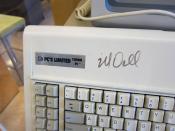EXECUTIVE SUMMARY
Dell experienced considerable success between the years 1994 and 1998 by effectively eliminating the middle man. This "Direct Model" approach revolutionized the way computers were sold, as well as how computers were built, marketed and distributed. Nevertheless, it also presents strategies employed by Dell's competitors to mimic its strategy.
Michael Dell's business model consists of selling the company's products to customers based on a direct-sales model approach, using the Internet and networks as distribution channels, ultimately making it easier for customers to contact Dell directly. The company books and receives payment before ordering the goods necessary in order to assemble devices, which allows Dell to have a negative cash conversion cycle. It also uses Just In Time inventory management, avoiding the risks associated with handling large inventories. Computer manufacturers attempted to adapt this business model, but they have not achieved the same results as Dell.
Another powerful weapon used by Dell's business model was customer segmentation, which led the company to offer what each client wanted, providing products customers wanted to buy, instead of new technology that may not be practical for the users.
Dell's ideas and business model can be summarized as a move to get close to the customer, by selling the products directly to them, gathering information about the likes and dislikes of the public and providing professional product and technical support (as simple or complex as it may sound).
After a lack of performance when prices for memory and processor chips fell, management at Dell was able to create an effective supply chain, implementing a "Just In Time" process with its suppliers, reducing its inventories, storage and transportation costs accordingly; thus, reducing exposure to devaluation of components.
The article reveals why Dell's competitors could not maintain its high market share of, for example in...


